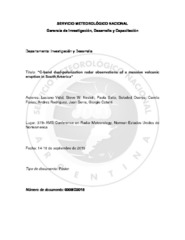Mostrar el registro sencillo del ítem
C-band dual-polarization radar observations of a massive volcanic eruption in South America
| dc.contributor.author | Vidal, Luciano | |
| dc.contributor.author | Nesbitt, Steve | |
| dc.contributor.author | Salio, Paola | |
| dc.contributor.author | Osores, María Soledad | |
| dc.contributor.author | Farías, Camila | |
| dc.contributor.author | Rodríguez, Andrés | |
| dc.contributor.author | Serra, Juan | |
| dc.contributor.author | Catanti, Giorgio | |
| dc.date.accessioned | 2017-02-14T16:04:15Z | |
| dc.date.available | 2017-02-14T16:04:15Z | |
| dc.date.issued | 2015-09-14 | |
| dc.identifier.uri | http://hdl.handle.net/20.500.12160/120 | |
| dc.description | Trabajo presentado en la 37th AMS Conference on Radar Meteorology, en Norman-Estados Unidos de Norteamerica, del 14 al 18 de septiembre de 2015. | es |
| dc.description.abstract | Several volcanic eruptions worldwide have been observed by ground-based weather radars but most of these observations were performed by single polarization radars. Dual polarization technology produce additional data fields which can provide valuable information on the structure and composition of an eruption column and ash cloud and can be used to determine the ash volume, total mass and height of eruption clouds. In the evening on 22 April 2015 at 21:04UTC, Calbuco volcano had the first eruption after more than 50 years of being dormant, producing a 15 km ash cloud. Seven hours later, a massive second explosion occurred on 23 April 2015 at 04:00 UTC producing a 20 km ash cloud that penetrate the tropopause and injected a lot of ash into the stratosphere. Calbuco is a stratovolcano in southern Chile at 41.326 S - 72.614W with an altitude of 2003m amsl. The eruption of Calbuco was the first volcanic eruption detected by weather radar in South America and in particular with the first domestically-produced Argentinian weather radar called RMA0 located in Bariloche (Rio Negro province). It is a Doppler Dual Polarization radar at C-band manufactured by INVAP S.E. as a part of the new radar network for Argentina. The aim of this study is to present analysis of the time evolution of the structure of the volcanic plume using polarimetric variables (e.g., horizontal reflectivity, differential reflectivity, and correlation coefficient) in order to explore the potential of this new data set in the analysis about structure and composition of this particular eruption column and subsequent ash cloud. T-matrix simulations will be used to develop a hydrometeor classification for ash, low density ice-ash, mixed-phase regions, and ice clouds to quantify the time evolution of the volcanic plume. Comparisons with lightning network data will be used to examine links between mixed-phase cloud development and cloud-to-ground lightning activity. | es |
| dc.language.iso | eng | es |
| dc.publisher | Servicio Meteorológico Nacional. Gerencia de Investigación Desarrollo y Capacitación. Departamento de Investigación y Desarrollo | es |
| dc.subject | ERUPCIONES VOLCÁNICAS | es |
| dc.subject | CENIZA VOLCÁNICA | es |
| dc.subject | RADAR DE DOBLE POLARIZACIÓN DUAL | es |
| dc.subject | VOLCÁN CALBUCO | es |
| dc.subject | NUBES DE CENIZA | es |
| dc.subject | RMAO | es |
| dc.subject | NUBES DE HIELO | es |
| dc.subject | REFLECTIVIDAD HORIZONTAL | es |
| dc.subject | HIDROMETEOROS DE CENIZA | es |
| dc.title | C-band dual-polarization radar observations of a massive volcanic eruption in South America | es |
| dc.type | Working Paper | es |
